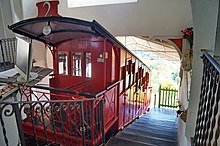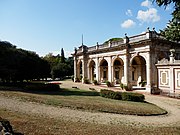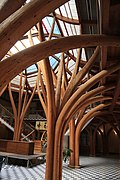Montecatini Terme
| Montecatini Terme | ||
|---|---|---|

|
|
|
| Country | Italy | |
| region | Tuscany | |
| province | Pistoia (PT) | |
| Coordinates | 43 ° 53 ' N , 10 ° 46' E | |
| height | 29 m slm | |
| surface | 17.66 km² | |
| Residents | 20,995 (Dec. 31, 2019) | |
| Population density | 1,189 inhabitants / km² | |
| Post Code | 51016 | |
| prefix | 0572 | |
| ISTAT number | 047011 | |
| Popular name | Montecatinesi | |
| Patron saint | Santa Barbara (December 4th) | |
| Website | Montecatini Terme | |
 Panorama of Montecatini Alto |
||
Montecatini Terme is a town and municipality in Italy with 20,995 inhabitants (as of December 31, 2019) in the province of Pistoia in Tuscany . The city is home to an important thermal bath , which makes tourism one of the area's main economic activities. There are over 200 hotels of all categories in Montecatini Terme. Montecatini is also considered a center of Art Nouveau architecture.
Location and dates
Montecatini Terme is located in the center of Valdinievole, about halfway between Florence and Viareggio .
The mountain village of Montecatini Alto belongs to the municipality , whose original settlement core is connected to the main town by the Funicolare di Montecatini Terme , one of the oldest funiculars in Italy still in operation .
history
From the Middle Ages to the Medici
The existence of Montecatini Castello, today's Montecatini Alto, was already attested in the Middle Ages, when a thermal center was already documented. Similar to the existing spa in the settlement, one was later to be built on the plain thanks to the salty water in the area. This is shown by a document from 1340 relating to the extraction of salt from water. There is also a letter from the merchant Francesco di Marco Datini , who asked his doctor about the medicinal waters of the Bagni di Montecatini. Further testimonies come from the famous doctor Ugolino da Montecatini, who had the waters examined using scientific methods for the first time. It shows that there were three Bagni di Montecatini: the Bagno della Regina , the Bagno dei Merli and the Bagno Nuovo . Bagno Nuovo , the “new bathroom”, is known today as Tettuccio .
In the Middle Ages, the city's inhabitants were in real hardship and had to endure epidemics, diseases and wars. The battles between the cities of Florence , Pisa and Lucca, which fought for Montecatini, forced the population to move into the hills around Montecatini, as the city floor was the scene of uninterrupted clashes. It should also be remembered that Montecatini was mainly made up of swamps. This was already mentioned by Titus Livius when he described how Hannibal crossed the "Padule di Fucecchio" on his march south. From the 10th century until 1270, attempts were made with the Republic of Lucca to drain the area hit by the malaria epidemic, but the work was unsuccessful and ponds were created where the water stagnated.
In 1315 the site was the scene of the battle of Montecatini , in the Uguccione della Faggiola , then lord of Pisa and Lucca, and a coalition of forces from the cities of Florence, Siena , Prato , Pistoia , Arezzo , Volterra , San Gimignano , San Miniato with the support of the Angevin of Naples , clashed. In this battle many men were killed in the muddy waters of Montecatini. It is believed that Dante Alighieri also took part in this battle.
From the Signoria dei Medici in Valdinievole to the takeover by Habsburg-Lothringen
From 1339 the Valdinievole was under the rule of Florence, thus the Medici , who brought the baths and the city of Montecatini no significant use. Cosimo de 'Medici was the first to build a bridge dam to cross the area's muddy waters. The initiative brought economic improvements but was detrimental to the residents of Valdinievole. In 1447, Florence approved a contribution to the restoration of the thermal baths.
In 1529 and again in 1538, for financial reasons, the owner of the Bagni di Montecatini offered his property to Cosimo I de 'Medici , who became duke in 1537 and was made grand duke by Pope Pius V in 1569 . Since Cosimo's wife Eleonora de Toledo used the baths of Montecatini frequently, the Medici analyzed the baths from their agents. An acquisition did not come about afterwards.
During their reign, the Medici had earned money by leasing farms and fishing, among other things. Therefore it was possible for them to defend the inhabitants of the region and to give them financial help to pay for the draining of the swamps.
During this time, Valdinievole had seen its population and economy grow, but epidemics repeatedly occurred between 1500 and 1756 , as meadows, forests, fields and pastures were flooded.
Montecatini was already a place known for slaughter ; In 1554 he was at the center of the clash between Charles V , an ally of Cosimo I de 'Medici, and the Sienese and French militias who had settled in the castle of Montecatini under the command of Pietro Strozzi . So Cosimo had the castle torn down.
In 1737 the Medici family died out. The great European powers, gathered in Vienna in 1738, agreed that Tuscany would be assigned to the House of Habsburg-Lothringen .
The Habsburg-Lothringer: founders of the spa town
Franz Stephan von Lothringen and Maria Theresa von Habsburg went to Florence in 1739, where they stayed for three months. Then they handed the government over to a Regency Council, which was in power until 1765. During those years epidemics and famine reappeared. To solve the problem it was necessary to colonize the land near the Padule by channeling the stagnant spring water in Valdinievole, thereby revitalizing agriculture and livestock.
After the death of Franz Stephan in 1765, it was his second son Pietro Leopoldo who inherited the title of Grand Duke of Tuscany after his mother, Maria Theresa of Austria, carefully prepared him for the duties of a ruler. In 1790 he inherited the Vienna throne for only two years, because in 1792 he died completely unexpectedly.
When Pietro Leopoldo arrived in Tuscany in 1765, he immediately proved to be open to innovation. During his reign he transformed the Palazzo Pitti into the seat of the wisest, fairest and most progressive European government of its time. He was also a promoter in the economic, public, health and scientific fields. As a reformer, he knew how to treat Tuscany as a nation with common customs and values. He went to Montecatini several times to understand firsthand the inconveniences of the Valdinievole. The history of the baths began thanks to the Grand Duke Pietro Leopoldo. He had scholars inspect the territory and tried to make the correct and most sensible decisions for the territory. The Grand Duke went to Montecatini in 1772 and ordered the demolition of the castles and weirs of Ponte a Cappiano . The canalization of the thermo-mineral waters began and the restoration of the city began, realizing the concept of a modern spa town. Pietro Leopoldo returned to Montecatini several times, including with his family, to check the status of the work. On March 1, 1790, he left Florence to return to Vienna to replace his late brother Joseph II .
The third Habsburg-Lothringen Grand Duke was Ferdinando III. who ascended the Tuscan throne at the age of just 21. Due to the Napoleonic occupation, he did not have an easy government and followed a neutral line in the first years of his rule. He was exiled by Napoleon and when he returned to Tuscany he was very active in rearranging the questions that arose as to French domination. He implemented a policy of true tolerance. On June 10, 1817, the "Bagni di Montecatini complex" was handed over to the municipality by Ferdinando III. This received an adequate amount of money to be able to maintain it. Since June 18, 1818, the baths have been headed by a deputation made up of respected people of the time, including Giuseppe Giusti's father. With this new management of the baths there were innovations and improvements.
As Ferdinando III. He died in 1824, followed by Leopoldo II , who is known for the reclamation work in the Maremma , the construction of railways and roads. The Lorraine period ended under the pressure of the Risorgimento with the simultaneous end of the Grand Duchy of Tuscany as part of the Italian unification in 1859.
History from 1860
In 1860 Montecatini came to the Province of Lucca with its seat in Montecatini Alto. From 1889 the city became active in the field of thermal medicine thanks to the Florence International Medical Congress . In the same year, the city project proposed and initiated by Pietro Leopoldo was expanded and improved. In 1898 the funicular to the Castello was inaugurated. From 1904 to 1915, the thermal baths of Torretta and Excelsior were founded.
Ugo Giovannozzi restored the Leopoldine Baths and the Tettuccio Baths from 1919 to 1928. Mussolini also visited the facilities to control the use of the money granted by the state for the restoration; he appointed Arturo Schweiger as managing director of Terme. Since the 1970s the baths experienced a slow decline, which since the 1990s attempts have been made to revitalize the spa.
On October 28, 1928, the name was changed from Bagni di Montecatini to Montecatini Terme. In 1928 the municipality of Montecatini went together with all the other municipalities of the Valdinievole from the province of Lucca to the newly formed province of Pistoia .
From 1900 to 1980 the population rose from 6,000 to over 21,000.
Attractions
Among the most important thermal complexes in the city are the Excelsior thermal baths, the first building of which was inaugurated on June 27, 1907, the thermal baths La Fortuna, the source of which was discovered in 1853, the Nuove Redi thermal baths, which were founded in the 1920s and in the The Tettuccio-Therme, which was designed by Gaspare Maria Paoletti between 1779 and 1781, the Leopoldine-Therme from 1775 and the Torretta-Therme, which were restored between 1925 and 1928, were completely rebuilt in 1964. The city is also rich in religious and civil buildings. These include the Church of Santa Maria Assunta, the Church of Santi Jacopo and Filippo, the Monastery and Church of Santa Maria a Ripa, the Villa Forini Lippi, the Palazzo Comunale and the Padiglioncino Tamerici.
- In the town hall, the colonnades and the vault have frescoes by the artist Galileo Chini.
- About 1.5 kilometers north of the village is the stalactite cave Grotta Maona ; it is open to visitors from April 1st to October 15th.
- The place has a privately operated funicular, which is identical to the Nerobergbahn in Wiesbaden, but is operated electrically.
Padiglione Portoghesi , 1987 by Paolo Portoghesi
traffic
At the northeast end of the spa park of Montecatini Terme is the valley station of the funicular, which goes up to the original town of Montecatini Alto . A local minibus also drives to the mountain village every hour from the bus station.
literature
- Andreini Galli Nori: Montecatini del passato prossimo. Comune di Montecatini, 1980.
Movie
- Montecatini - The healing springs of Tuscany. Documentary, Germany, 2011, 43 min., Script and director: Nina Koshofer, production: Tag / Traum, ZDF , arte, first broadcast: June 1, 2012 on arte, series: Kur Royal (3/5), film information from arte.
Web links
- Information for tourists, video clip, interactive map
- Side of the Montecatini thermal baths (German)
Individual evidence
- ↑ Statistiche demografiche ISTAT. Monthly population statistics of the Istituto Nazionale di Statistica , as of December 31 of 2019.
- ↑ ISTAT















